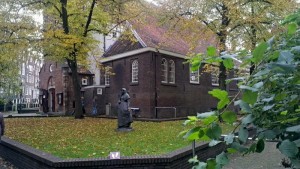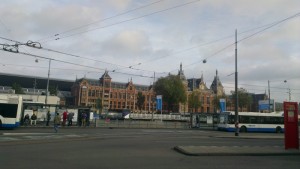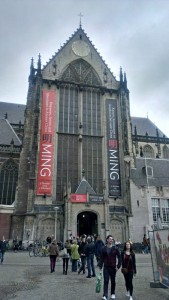I feel like so much happened in Amsterdam in such a very short space of time. After I visited Begijnhof, I contemplated going to the Amsterdam museum nearby, but it was starting to get late so I didn’t think I’d have time. Instead I set off by a round about route to go back to the hostel. On the way, I thought I’d stop into another of the many churches indicated on the map. I didn’t ever find that church, come to think of it. Instead, at the end of a canals I found the Amsterdam University Academic Club, complete with a list of public lectures and debates and a menu for the little restaurant. It wasn’t open at the time but someone I felt I’d found the Europe I’ve read about all those years – the continental intellectualism and engaged discussion, down the street from old, old churches and stately traditions and between rows of neat red-brick buildings, under a steel-grey sky.
I walked along beside a small canal, along the street and past Bulldogs – apparently the first of the Amsterdam “coffee”-shops. One of many. I suppose because of the narrowness of the roads, all the chairs outside the coffee shops are set so that the patrons sit with their backs to the wall or canal looking at all the people walking past. Old men, couples, stoned people stare at you as you walk by. It’s a bit disconcerting
A little further up the street I came to the bulk of the Oude Kerk. This beautiful church is the original cathedral of Amsterdam. As I walked up, the hour struck four and the church bells rang out. I would hear the bells again many times in the next days in Amsterdam and they made me smile each time. The church is now used for many different purposes and remains an important part of the Catholic celebrations of the miracle of Amsterdam each March, which includes a silent procession through the old city. It is also a museum. I bought my ticket and went inside.
The first thing I noticed was the floor. The whole floor of this huge building is made up of large charcoal black stones – gravestones of generations of the people of Amsterdam. Under 2500 gravestones lie 10,000 people – rich, poor, ordinary, important – laid to rest beneath the floor of the church between 1300 and 1865, including, among many others, Rembrandt’s wife. Some of the stones are carved with intricate designs – crests, names, inscriptions in old Dutch. Some are plain and smooth. One is carved with the outline of skeleton.
Far above, the vaulted wooden ceiling rises in great sweeping arches. The ceiling is painted with crests and pictures. These pictures were only rediscovered during a restoration in 1956, because they were painted over with black paint when the city and the church became Protestant during the 1500s. On either side of the church, a wooden spiral staircase leads up to this ceiling roof.
Light streams in through stained glass windows, some dating from the 16th century, depicting stories from the religious to the patriotic. At the back of the church is a giant organ, decorated with cherubs and angels, above big wooden double doors. Past the wooden pews in the centre of the church, an intricately carved wooden screen separates the nave. Here the carved wooden seats of the choir stalls along either side depict a series of lessons and proverbs.
The building is cavernous and the ceiling rests on huge pillars. There are many plaques and remembrances, as well as examples of medieval and some more recent relics from churches around the country are have been brought here for safe-keeping as well. The only thing spoiling the visit was other tourists who were unfortunately a little noisy and limited real, social history explanations available.
From Oude Kerk, I walked a little further up the canal and passed the first red-light window I had seen, right opposite the wall of the church. It took me by surprise. As I walked back the hostel, the night began to fall. Sex shops opened their doors, the noise of pubs and coffee shops began to spill onto the street and crowds started to gather. I turned a corner, a few blocks from my hostel, and saw a young man staring longingly into a shop window. I sighed but as I got nearer I realised he was looking into a travel shop and thing that had caught his attention was little GoPro camera. It was so delightfully unexpected that I nearly burst out laughing.
I went out again later in search of dinner. Near the fun-fair, the crowds were growing and the noise and the lights were harsh. I headed down a street to escape the chaos but waitresses and restaurant owners kept leaping out and trying to convince me to patronise their establishments. The crowd seemed rougher than it had during the day. I broke away and re-found the lovely little canal I had walked along earlier. This time I walked along the other side and, before long, found an Argentinian Steakhouse with a little outside area right on the canal. I sat down at a table and watched the lights on the water and looked out at graceful bridges where cyclists and pedestrians went by. The waitress lit a candle and brought me a lovely dinner, followed by great coffee. The evening was warm and, tucked away at my little table, I felt like I’d found a little bit of old Europe.
After dinner, walking back, I could feel the frenetic, unsettled energy of the place. Everywhere was lights and glare and women in windows and men in black hoodies lurking outside certain establishments. I was glad to reach my hostel and feel like I could get a little bit of distance from this complicated city.
The first thing I heard in the morning was the churchbells from the Oude Kerk. Street cleaners and rubbish collectors were already on the move outside. I heard someone call out a greeting. It was early and the streets were calm again.
Downstairs, I had a good solid breakfast and then set off for a day of exploring. (Note to travellers, it appears most of central Amsterdam doesn’t open until after 10am.) First stop was the Amsterdam museum, which I managed to find after only one or two wrong turns. I had bought a ticket in advance at the hostel but there actually wasn’t any sort of queue. I wish I hadn’t. Not that I wish I hadn’t bought the ticket at the hostel; I wish I hadn’t bought it at all. I love museums. They’re one of my favourite parts of travel. And I have seen some that are not great and some that are absolutely fantastic. This was the first museum I think I’ve visited that has ever disappointed me so much.
When I arrived in the Netherlands, I was struck by how little I knew about the country, but one of the things I love about travel is learning about the places I visit, so I’d been reading and learning and finding out ever since. I had discovered a complex history of conflict, social upheaval, innovation and development, with threads of remarkable continuity and resolution and feats of invention and engineering. Instead of celebrating and recognising that, instead of telling stories, this museum could have been set up by a bad spin doctor. It was as if someone had gone through the history and picked out a few random moments when Amsterdam was somehow the best or biggest or most commercially important city in the Western world and simply ignored the rest. Most of the exhibitions were a few artefacts or famous paintings against a backdrop of cartoon drawings, quizzes and “did you know” factoids, mediated through carefully scripted video pieces.
There was no reflection on the meaning of empire, slavery, exploration, religious intolerance or subjugation by other nations. No exhibits depicted the great fires and the struggles to rebuild. Struggle was not a part of this narrative. Coming, as I do, from a “new world” perspective where struggle and fortitude and overcoming overwhelming odds are the very DNA of our societies, this seemed both strange and unnecessary – it made the history feel artificial. Also, of course, the social history trained student in me was cringing at the “great man” telling of history. The bits of history not confined to cartoons and slide show videos were show through famous paintings of famous people, along with some of those famous peoples’ possessions. The only mention of violence was a little bit about the guillotine being introduced and used just once, in a cartoon drawing of three headless street-sign style figures with three dots (heads) bouncing away.
By the time I got to the video showing the Dutch arriving at the Cape to a fully constructed castle and staying to build modern Cape Town before sailing on to Indonesia, I had had more than enough. I think it wasn’t the shortest time I’ve ever spent in any museum. I marched off up the road, no destination in mind and kept on walking until I found myself back at the station.
There I noticed the adverts for canal cruises. I’d been thinking about doing this and suddenly it looked like a great idea. It was. I found a reasonably priced option (don’t think about the exchange rate!), bought a ticket and headed for the boat. The cruise was magical. Through the old harbour, past the science centre and into the old, tree lined canals. Past the beautiful houses and the riches of Golden Bend. Past houseboats – on one a toddler looking out from behind behind a glass door, so wishing to join the fun; on another, a full-blown garden of flowers and plants. Past the Lord Mayor’s residence and the narrowest house in Amsterdam (just 1.5m wide).
The cruise director pointed out the “dancing houses” – the buildings leaning slightly as the wooden poles on which they rest, begin, over centuries, to slide into the canal. We passed the beautiful Westerkerk and the Anne Frank House – the guide pointing out where the family had lived. It was a gentle cruise with many human stories – just the sort of history I had been hoping to find.
All too soon – but definitely worth the money – we passed again into the harbour, past the newly completed Palace of Justice and returned to the stately old Central Station. I seriously considered trying to find another cruise but decided I should stop while I was ahead.
The rest of the afternoon I spent walking, wandering. I left the city centre and walked in the direction of what was shown on my map as the Dutch East India Compound. I didn’t actually find it (I think I missed a turn) but I did get a chance to wander through what felt a little more like real Amsterdam with real people living in it. I still found the cyclists everywhere a little terrifying but it felt good to be out of the crowds – more peaceful and ordinary, more normal away from the tourists. On the way back, I stopped at the VOC café and sat on a balcony, overlooking a beautiful canal and had a glass of wine and some “warm traditional Dutch snacks”.
And that was it. Well, almost. I headed back to towards Dam Square in the late afternoon, to buy a few souvenirs of my visit. I was walking along, enjoying the houses and the streets and the slightly less crazy crowds. As I walked, I was idly looking into the windows of the shops I passed, window-shopping as I often do, when suddenly I found myself looking at a mostly naked woman. Of course, the evening was coming and the red lights were on – which I would of course have noticed had I been paying more attention – but it still came as a bit of a jolt, a bit unexpected when I wasn’t paying attention.
The next morning, early enough that the streets were almost deserted except for the cleaning crews and a few people cycling to work, I walked to the station, took a train to the airport and headed home. I’d been in the Netherlands only a few days but I felt like I’d seen so much on my very first trip to Europe.


